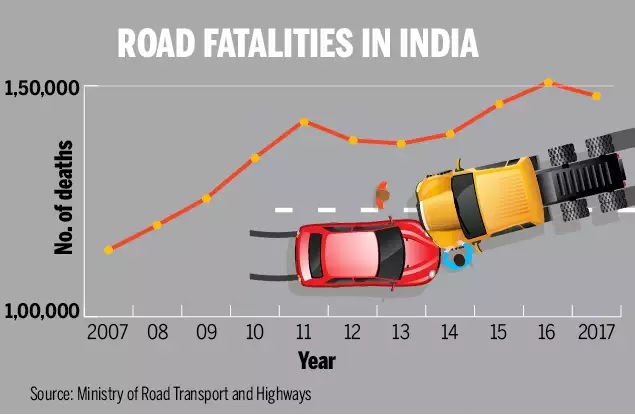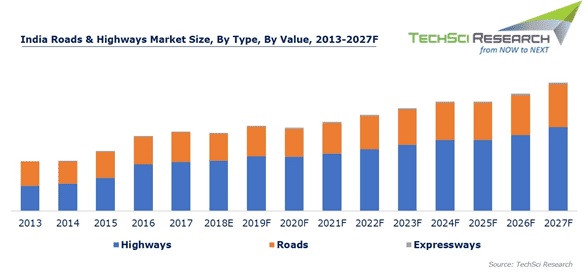Driver Drowsiness and Attention Warning ( DDAW) – Attentive Driving for Safer Indian Roads

An increase in automobiles on roads comes with the ever-present threat of fatalities especially on account of distracted and / or sleepy driving. The following graph shows the rise in accidents in India over the years. The country holds the dubious distinction of highest road accidents and fatalities globally.
Consumer demand for more and better safety features and the supportive regulatory environment in India have made Driver Drowsiness Attention Warning (DDAW) an important consideration in the upcoming new vehicles.
As per EU definition, DDAW is defined as a system that assesses the driver’s alertness through vehicle systems analysis and, where needed, provides a warning to the driver. In particular, DDAW detects or recognises the driving pattern, Percentage closure/opening of eyelids and gaze and/or
steering pattern symptomatic of a driver exhibiting reduced alertness due to distraction, fatigue, etc. and interacts with and alerts the driver via the vehicle’s human-machine interface.
You can read our previous article about driver monitoring system here.
The EU norms expect all new vehicles to be DDAW enabled effective July, 2022. India follows EU by about 1 or 2 years for implementation of most automotive regulations. And even that gap is narrowing day by day. Recently in a tweet, the union minister for Road Transport & Highways proposed a policy to include On-Board Sleep Detection Sensors in Commercial Vehicles, on par with European Standards. He has also proposed fixed driving hours for truckers in order to mitigate fatigue-induced road accidents. A month-long campaign called the National Road Safety Month was held, earlier in the year, as an opportunity for all stakeholders to join hands to make road safety a critical mission. It engaged OEMs, Insurers, Automobile Associations and many other organisations and state ministries in this campaign for awareness and an urgent action plan.
Commercial Vehicles Taking the Lead in implementing ADAS – DDAW
Drowsiness detection systems as a part of advanced driver assistance systems (ADAS) are becoming a part of heavy commercial vehicles in India as fatigue-induced accidents are more common for such vehicles. to introduce an innovative AI and computer vision technology-based driver state monitoring system in their trucks. The system is able to differentiate between safe driving conditions or driver drowsiness and inattentiveness and give acoustic and visual alert.
In a first, officials of the Motor Vehicles Department have developed a driver drowsiness and fatal accident prevention system with a combination of six commonly available devices, the night vision camera being the most prominent one for recording facial changes. The response time of this system is quite fast, and a vehicle whose driver dozes off can be brought to a halt in seconds, as the night vision camera can capture six frames per second. Research is ongoing to improve and customise the speeds. The motor vehicles department team is trying to patent its low-cost technology which it sees as essential for long-distance buses, lorries and cars.
Passenger Vehicles not far behind
As the above graph shows, India has seen an exponential rise in highways and road connectivity. With disposable incomes rising in a young nation, Indians are cruising for long drives, family vacations and backpacking trips from one part of the country to the other. Having advanced safety features like DDAW is now seen as a must before undertaking longer road trips.

The latest in news, Mahindra XUV 700 features driver drowsiness detection system feature that will detect and alert the driver if he is falling asleep or dosing off. Developed in collaboration with Bosch Mobility Solutions the system also adapts speed of the vehicle to vehicles around you, switches to low beam in case of on-coming traffic and reads/ recognises road signs.
Indian OEMs are stepping up to offer enhanced safety features voluntarily. They know that these features will increase safety of passengers, mitigate accident rates and allow for higher NCAP ratings. Advanced driver assistance systems (ADAS) such as adaptive cruise control (ACC), automatic emergency braking (AEB), lane-keeping assist (LKA) and traffic jam assist (TJA) are being offered by OEMs such as Mahindra & Mahindra (M&M) and MG Motors.
Indian Opportunity
What is interesting to note is that while OEMs and their suppliers are aware of DDAW systems and there is a growing need for these safety features in vehicles, there is minimal presence of suppliers with such solutions. This gap in supply to the rise in demand is an excellent opportunity for foreign suppliers and collaborators to enter the Indian Market and gain market share.
Main demand for total solutions of advanced safety features has already begun from India’s leading vehicle makers – both PV and CV. While vehicle safety is a concern, so is cost. OEMs are looking for cost-effective ADAS to prioritize the performance-to-cost ratio of safety systems. Many OEMs are planning camera and radar based ADAS offerings.
Research by Frost & Sullivan indicates that Maruti Suzuki and Hyundai-Kia will likely lead volume growth in the safety features market and rightly so as they also have a high vehicle market share. However, OEMs that are just a step behind, such as Toyota, Mahindra, MG Motors and Volkswagen already exhibit a higher penetration of safety features especially in their newly launched models.
Vehicles having DDAW and other ADAS features are likely to have competitive advantage in the near future.
All trends show that the Indian market is gradually moving toward Level 2 safety features. More and more models with camera and radar based ADAS systems will be launched in the near future, with such systems set for explosive growth from 2025.
To know more about market demand for DDAW in India contact me at sudhir.nerurkar@quanzen.in




